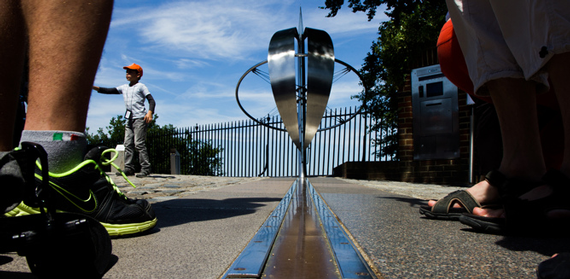Image: Sameer Walzade/flickr
Guest post by Matt Blacklett
If you’ve ever been to the Royal Observatory in Greenwich, London, it might come as a shock to learn that the Prime Meridian line located there is in the wrong place. In fact, it’s out by about 100 metres.
Since the late 19th century, the Greenwich Meridian has been the line at which most maps mark 0° longitude, the starting point for measuring geographical coordinates in an east-west direction. But we now know that the line, a physical representation of which is visited by thousands of tourists every year, should more precisely be 0.001472° (or 102.5 m) further east.
How did the Victorian astronomers who created the Meridian get their calculations wrong? It comes down to the fact that the Earth is not a perfect sphere. In order to determine the precise angle at which to position the line as it ran through the Greenwich Observatory, its creators used early instruments that were aimed vertically at what are called “clock-stars” in the night sky. These are the brighter stars, whose positions have been observed over long periods of time and can be used as reference points in the sky.
To find the exact vertical direction (a line pointing at the precise centre of the Earth’s mass) the Observatory’s astronomers first found the exact horizontal direction (at 90° to the vertical) by looking at the surface of a pool of mercury in a basin.
This method, however, assumed that the Earth’s gravitational force that created the horizontal surface on the mercury was both uniform and straight down. But because the Earth is not perfectly round and local gravitational forces vary with terrain, the surface of the mercury at Greenwich was not precisely horizontal relative to the centre of the Earth’s mass. As a result, the vertical line to the stars and therefore the meridian line on the ground were slightly skewed.
Today, we have the significant advantage of access to the satellite-based Global Positioning System (GPS), which does not rely on the Earth’s varying gravitational force and uses a more accurate method to calculate the centre of the planet’s mass. This has enabled scientists to determine the true vertical direction and in doing so produced a new meridian slightly to the east of the old one. Because the Earth isn’t a perfect sphere, it was impossible to simply move the new line over and maintain an accurate coordinate system.
Does it matter?
So what are the implications of this apparent inaccuracy, particularly given that it is the location from where every place on Earth is measured and from which all clocks are ultimately set? Fortunately, the answer is none, really.
We must remember that the position of the Prime Meridian is actually rather arbitrary and could theoretically be located anywhere. Its location through Greenwich was agreed at the International Meridian Conference of 1884 because it was the most popular candidate. Before this point, roughly ten other prime meridians were also in use, including ones through various other cities including Paris and Cadiz.
Because all important scientific measurements are today made using GPS and not the original location of the Greenwich Meridian, the impact of the error is actually minimal. Arguably, the main issues are confined to the Royal Observatory itself and how it plans to address the issue at the tourist site. There is certainly an argument for a new marker at the “true” Prime Meridian 102m to the east (although being set in one of London’s heavily regulated Royal Parks might make this somewhat problematic).
And where should we envisage the true Prime Meridian? Certainly, the new location is the more accurate line and the one that will be used in the future. But we shouldn’t forget the groundbreaking work that was conducted by scientists in centuries past with only limited tools. The fact that the two lines are just 100m apart is testament to their hard work and ingenuity and so disregarding the old line would be disrespectful. The old line will remain a historic and scientific curiosity, while the new one will allow for ever more accurate navigation within the Earth’s terrestrial, oceanic and atmospheric system.
Originally written for ‘The Conversation’.




Comments are disabled